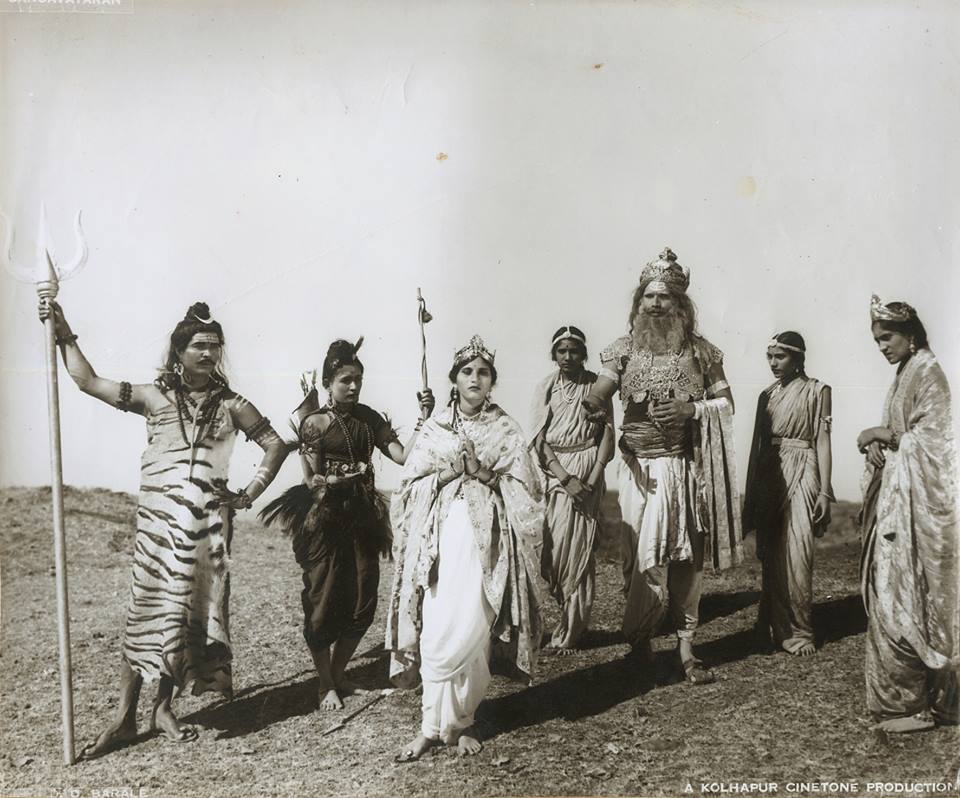The gate of those dreamers who trace, translate, repeat
William Jones Translates Kalidas' Shakuntala, goes over the text, word by word finding equivalences in the language he lives with. In the process, he sits intimately with Kalidas, and retraces his sumptuous bodied subject, but also the king on a hunt. William Jones sits at a late nineteenth century table ( painted backdrop) and as he translates, in that present, in that air, what he writes in is a dream of movement, of stilling it and rushing it. Muyerbridge's horses are written in, as the world over, machines conspire to give life to the genie of cinema, here in this study, a pen outlines, repeates the same dream. Maybe it requires that many wishes to make the image come alive? (baaad, shall write again)
M: A few colour xeroxes Atpat gave me, from a workshop, he told me, he held by the river side at Nasik. a typed timeline of Phalke's live, in the margin, in parallel, a typed timeline of technology year by year. Phalke, born in 70. He parses words to make his images, Atpat. or enters their meanings to find his road. He takes Kashyap. Kashyap the sage, that we know already. Kashyap also a turtle. he finds a picture of a turtle swimming underwater. the water flows right back to the womb where the embryo floats like a Kashyap. Atpat would enjoy the evolutionist Ernst Haeckel vision of the growth of the embryo being a mirror of evolution itself- from fish gills to tail to human.. modern biology might have disproved Haeckel but do we have an image of equivalent beauty and coherence? mirrors are central to Atpat's vision of art, are they not? i rifle through ( he would like that) the pages and find Toulouse Lautrec looking at himself in a fine early photo, two Lautrecs at adjacent canvases.
Words have to be broken open cracked open like nuts to show some kernel. Otherwise we are left with a dead language. what does it mean to say "Phalke became a megalomaniac in Kolhapur"? it is thick tarpaulin, cover of poreless plastic that inhibits experience. Instead there is a hillside filled with sun, 1937 and a bunch of actors. Gangavtaran. men still dressed as women so late into film history. or women overwhelmed by the sun, wilting in their zari shawls which along with the armours and beards and tiger skins of the other actors, indicate the offscreen presence of old costume trunks more than the gods. broad sunlight of 1937, motor cars somewhere below and a tired consciousness that is fiercely reviving itself, that is pushing, trying to force these dressed up human beings into movement, shaking what lies before him.. With the heat of his mind, putting aside apprehension, just doing with all he wills to parse the scenario and find a living moment of the story of the moment of the descent of one of our large rivers onto her bed on our earth
M
क्योंकि नकल से अकल आती है.
on the road, down the street.. contd. 87
M maybe there should be a gate of grammar. different grammars? philosophy as a grammar of life? no, philosophy is not about rules it is about looking at what feel like sources of life and the relationships between them Muktibody echoes thoughts on the vac- the word, when he says- हिन्दी में मन से ब्राह्मा वस्तु को ही वास्तु समझा जाता है- when he thereby puts aside the discussion of subjective and objective- because the object is that which is born of the mind. akin in the vac book to sound as an emanation of a creative process- and with the utterance, the object is created and then there cannot be a complete differentiation.
N
He is one of two characters talking, M, are you not taking him literally? His grim faced, well eyed, serious dull minded friend ( as reported by Muktibodh) disputes him, creates an outside outside of creation by the writer.. an objective world, that asks us to be still- he says- and make relationships.
